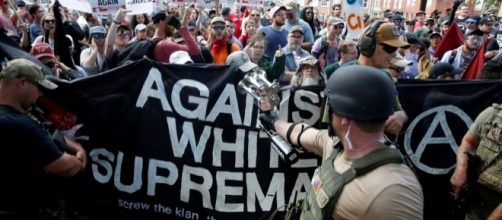On Aug. 11, hundreds of protesters gathered for a preemptive "Unite the Right" rally in Charlottesville, Va. to protest the removal of a statue of General Robert E Lee - a Confederate icon. Organized by Jason Kessler, the protest has been described as one of the largest white supremacist events in recent American history. This protest didn't occur on a whim. A number of events led to the ultimate eruption of violence in the university town.
How it began
The conflict began to brew within the community as early as February and March when the Charlottesville City Council voted to remove General Robert E Lee's statue from what was formerly known as Robert E Lee Park.
Some groups went as far as to file lawsuits, and when those failed, on May 13 a group of at least 100 white nationalists protested the statue's removal. They marched through the streets with torches in their hands, which was ill-received many politicians and the social media world alike. The city's mayor, Mike Signer, also expressed his disgust of the white nationalists' actions and reiterated that his city was one that takes pride in it's values and diversity. To further solidify his stance and his point, Signer renamed Robert E Lee Park to Emancipation Park on June 5.
The 'pre-rally'
White nationalists, again brandishing torches, held a preview the day before the "Unite the Right" protest. The rally was intended to be a gathering of white supremacists who were determined to demand the statue of Lee be protected.
Their chants of "white lives matter," "you will not replace us," and a Nazi-affiliated phrase "blood and soil" echoed throughout the University of Virginia's streets. When fights began to break out between the white nationalists and counter-protesters, the police arrived on campus to declare the scene an unlawful assembly and ordered the crowd to disperse.
However, the damage had already been done: the combined effect of the fights between the protesters and the counter-protesters and the explosive response on social media, the atmosphere was rife with tension and perfectly primed for the violence that would take place the next day.
The 'Unite the Right' Rally
On Aug. 12, violence broke out again between the white supremacists and the counter-protesters before the Unite the Right rally - which was scheduled at noon - even began.
Not long after, state police began to report injuries and the city of Charlottesville declared the gathering at Emancipation Park an unlawful assembly. By 11:28 a.m. a local state of emergency had been declared by both the City of Charlottesville and the County of Albemaerle.
Despite these efforts, the violence continued, reaching it's forte at 1:42 p.m., when 20-year-old James Alex Fields Jr. of Maumere senselessly rammed his speeding Dodge Challenger into a crowd of counter-demonstrators before fleeing the scene. It has been confirmed that his actions led to the death of a 32-year-old woman, Heather Heyer, and to the injuries of at least 35 other people; 19 of them confirmed by the Charlottesville hospital.
Two other deaths related to the incident have been reported: Lieutenant H. Jay Cullen and Trooper-Pilot Berke M.M. Bates - both Virginia State Police troopers - died when their helicopter crashed while they were giving air support to the deadly violence occurring in the city.
The Aftermath
On both Aug. 12 and 13, vigils and marches of solidarity have occurred throughout the nation in remembrance of Heyer and against white nationalism. The driver of the car, James Alex Fields Jr. was apprehended by the authorities not long after he fled the scene. He is now facing a number of charges: one count of second-degree murder, three counts of malicious wounding, and one count of hit-and-run for his reprehensible and violent actions. In addition, the Department of Justice has opened their own investigation into the incident.


